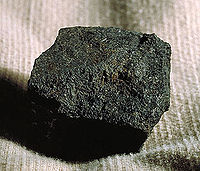
Photo from wikipedia
Our article includes numerical analysis of one narrow slice of a complex phenomenon called the greenhouse effect. We consider the most important fossil fuels: natural gas, crude oil and coal,… Click to show full abstract
Our article includes numerical analysis of one narrow slice of a complex phenomenon called the greenhouse effect. We consider the most important fossil fuels: natural gas, crude oil and coal, and calculate their impact on the average concentration of carbon dioxide in the Earth’s atmosphere if all the known reserves of these fuels were burned out altogether. Our calculations are based on the known amounts of the reserves and stoichiometric burning of the fuels. We do not take into account any cumulative effects and time related processes in the biosphere. The calculations yield that the largest effect would come from burning all the known reserves of coal, and the smallest effect would result in from burning all the known reserves of natural gas. The average concentration of carbon dioxide would increase from the present value of 405 ppm-v to about 873 ppm-v if all the known reserves of all these fossil fuels were burned. Our analysis has its roots on a cynical approach to the human race: it is totally possible that all the fossil fuels will be totally burned, sooner or later. It is important to have numerical analysis on such a worst-case scenario now when we still have massive reserves left in the ground and in vast stocks.
Journal Title: Applied Categorical Structures
Year Published: 2020
Link to full text (if available)
Share on Social Media: Sign Up to like & get
recommendations!